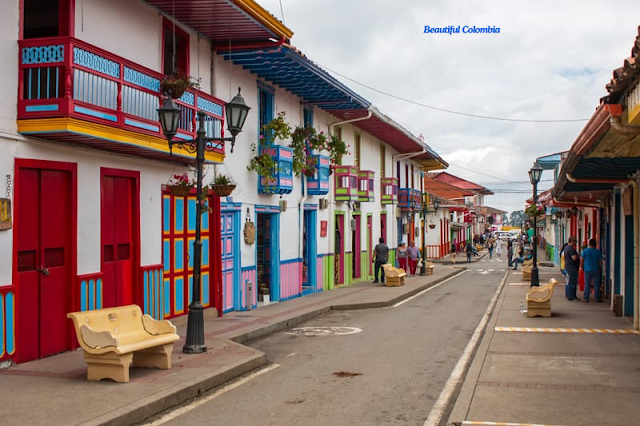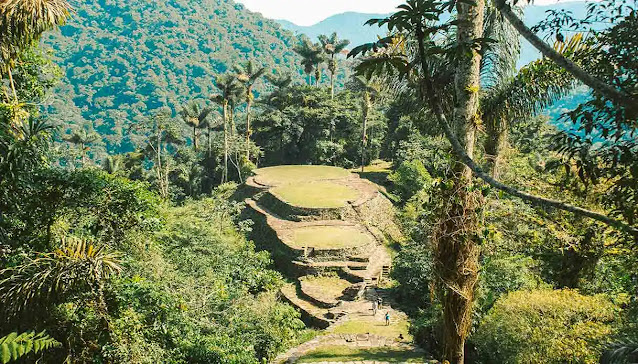long before the arrival of the Europeans the land that we now call Colombia was inhabited by indigenous peoples who had rich and well-developed cultures among the best known were the Muisca the Tairona and the Quimbaya
the Muisca lived on the highlands near where Bogotá is today and had an organized society with chiefs called zipa and zaque they grew corn potatoes and cotton they worked gold with great skill and believed in gods linked to nature one of their most famous rites was the one that gave rise to the legend of Eldorado the chief covered his body with gold dust and dived into a sacred lagoon offering gold to the spirits
further north on the coasts and in the mountains of the Sierra Nevada of Santa Marta lived the Tairona a people who built stone villages like the site called Ciudad Perdida they used terraces to cultivate and had refined craftsmanship made of ceramics precious stones and metals they lived in harmony with the jungle and with a complex social structure
the Quimbaya instead lived in the area of the current Eje Cafetero and are famous for their goldsmith art especially for their gold figures known as poporos and ritual statuettes worked with advanced techniques for the time they were skilled farmers and used the Magdalena River as a trade route
these people did not have writing but transmitted their stories with the word and through symbols carved in their objects and ceramics when the Spanish arrived in the sixteenth century they found these cultures alive but already changed by centuries of contact between them
the Spanish conquest brought destruction diseases and profound changes but even if many aspects of the pre-Columbian cultures were lost today the descendants of these people continue to honor the traditions languages and ancient knowledge keeping alive the memory of a Colombia that existed long before Colombia
Ancient Colombia more fascinating than the Muisca
Muisca spoke a language called Chibcha and lived in villages built with mud and straw huts but had a very organized society they were divided into two large territories each governed by an important chief the zipa to the south and the zaque to the north these two leaders were not absolute kings but guided with the help of advisors and priests
The Muisca religion was deep and linked to the elements of nature they worshipped the sun the moon fire and above all the sacred lakes like that of Guatavita where the famous ritual of Eldorado took place every time a new zipa was chosen he covered his body with gold dust and dived into the lake offering precious gifts to the gods from the silence of the waters
Gold for the Muisca was not just wealth but a means to honor the sacred for this they created incredible objects with shapes of warrior animals and spirits they buried them in temples or used them in rites some of these masterpieces are now in the Gold Museum of Bogotá
the Muisca were also expert farmers they grew corn cassava pumpkins and potatoes and knew how to build irrigation canals and terraces on the hills they used salt as a trade commodity and were famous for their salt mines like those of Zipaquirá
when the Spanish arrived the Muisca tried to resist but were conquered little by little their cities were absorbed or destroyed and many rites forbidden and forgotten but the memory of their world survives in the stories in the names of places and in the people who still today recognize themselves as heirs of the Muisca
it is as if their history was hidden among the mountains and lakes ready to re-emerge from the mists every time someone decides to listen to it
today Colombia is a republic with a democratic government and a very young and diverse population in cities like Bogotá Medellín Cali and Barranquilla the modern heart of the country beats strongly between university art music and innovation
Colombia is famous in the world for its music that mixes African rhythm with indigenous melody and European influences cumbia vallenato reggaeton but also Andean and Pacific sounds each region has its own voice and drum
Colombian cuisine is another treasure rich in regional flavors from arepas to tamales from bandeja paisa to lechona to fish with coconut on the Caribbean coast and panela sweets in the Andean villages each dish tells a story
Colombia today is also one of the countries with the greatest biodiversity in the world it is home to the Amazon jungle the Andes the Caribbean and Pacific coasts the deserts of Guajira and the plains of Orinoquía unique animals and rare plants live here that make the territory a wonder to be protected
in recent decades the country it has gone through difficult times due to armed conflict and drug trafficking but it has also experienced a strong change with peace agreements social movements and a new generation ready to build a different future
today Colombia is a country on the path towards a balance between modernity and memory between city and nature between pain and hope it is a land where the pre-Colombian past lives alongside the murals of Medellín at the parties of Barranquilla and the literature of Gabriel García Márquez where every street can become a song and every smile a revolution







Leave a comment to help us thanks.